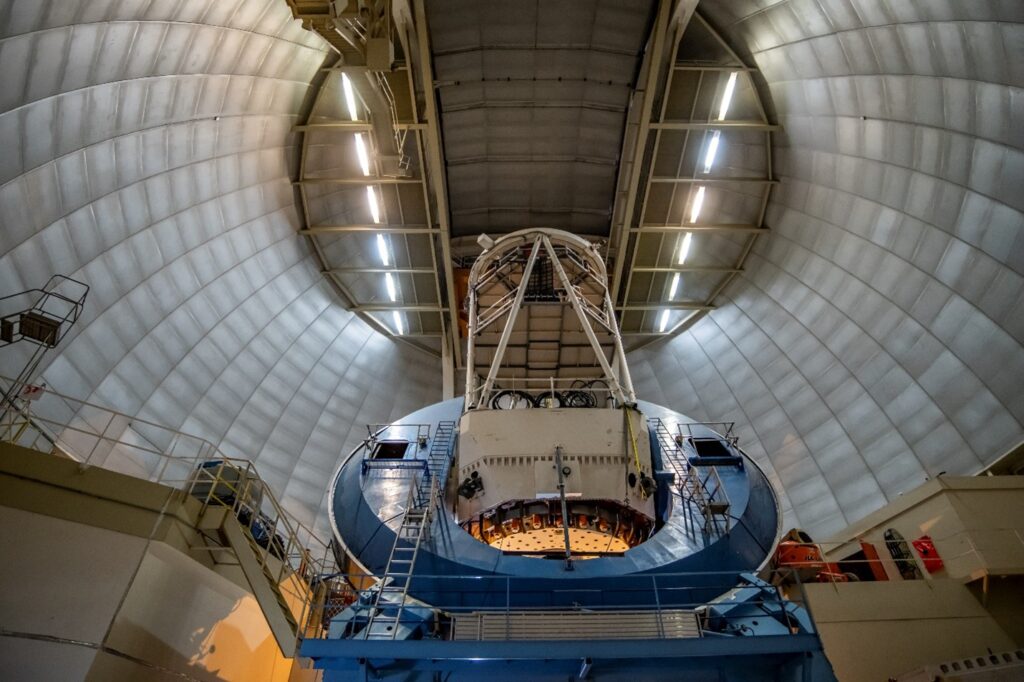
The Dark Energy Spectroscopic Instrument (DESI) sits on the Mayall Telescope in Arizona. Image: Marilyn Chung, © The Regents of the University of California, Lawrence Berkeley National Laboratory
By James Myers
Using 270 terabytes of data gathered by the Dark Energy Spectroscopic Instrument (DESI) in its first 13 months of operation, researchers have observed something surprising after examining nearly 15 million galaxies: the expansion of the universe appears to be slowing down.
Nearly a century ago, astronomer Edwin Hubble observed that the universe is expanding, but until 1998 it was thought that the rate of expansion was constant. In that year, astronomers established that the expansion is accelerating and, according to what is now called Hubble’s Law, galaxies are separating from each other at speeds proportional to their distance.
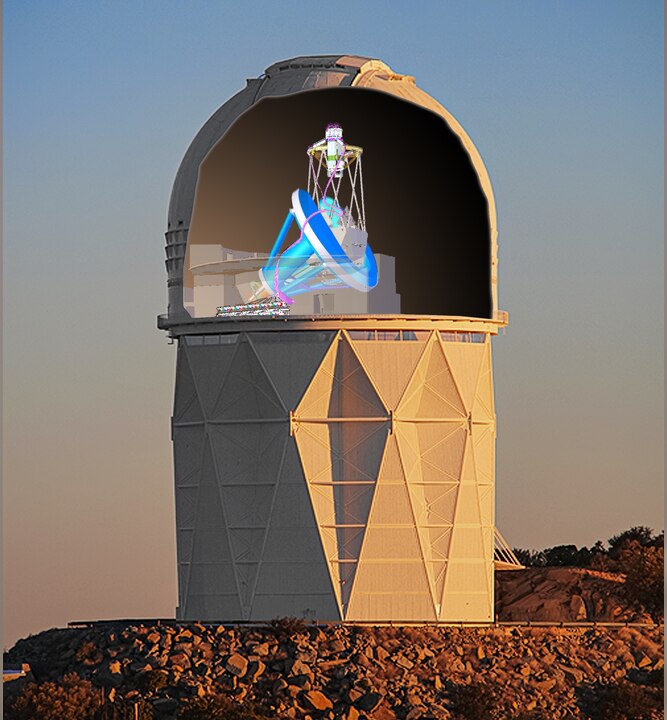
DESI sits atop the Mayall Telescope in Arizona. Image: Lawrence Berkeley National Lab/KPNO/NOIRLab/NSF/AURA, on Wikipedia .
If the expansion now appears to be decreasing, what could be responsible for the change?
What would a variable expansion rate mean for theories about dark energy as the force of expansion, and the long-held idea that the acceleration rate is constant?
It is widely believed that dark energy, theorized on the basis of its gravitational effect to constitute nearly 70% of the mass of the universe, is the force that propels physical objects further into space.
Called “dark” because we have no technology that can directly observe its properties, it is thought that dark energy exerts a form of negative pressure that prevents gravity from collapsing the universe in a “big crunch” over time.

Illustration and caption by Ann Feild, on Wikipedia .
With data from DESI, 900 researchers from 70 institutions are collaborating in investigating the anomaly of slowing expansion and other questions that could upend the standard model of cosmology. After decades of consensus that the acceleration rate for expansion is constant, the April 2024 announcement of differing rates measured has posed a serious challenge to what has become known as the “lambda-CDM” standard model of cosmology predicated on a constant acceleration rate.
The upgraded technology of DESI is building on 25 years of data from 9 million objects observed by its predecessor, the Sloan Digital Sky Survey. In 2020, the Sloan Survey published what was until then the largest 3D map of the universe, reaching as far back as 11 billion years with evidence that the universe is flat in shape while different regions appear to be expanding at different rates. A recently released reanalysis of the Sloan data supports DESI’s findings.
DESI has created the largest 3D map of the universe to study dark energy. In this animation, Earth is at the centre of a region of galaxies, each of which is a dot of light.
DESI is mounted on a telescope in Arizona and for three years has been measuring distances of light sources as far back as the Sloan Survey reached, within sections of the cosmos to create a detailed three-dimensional map.
Every 20 minutes, DESI takes 5,000 simultaneous images of stars, planets, and galaxies in a selected area, and the data collected from months of distance observations are added to a comprehensive map. Light from supernovas, which is emitted at a predictable frequency, is used as a guide in determining the relative distances of other light-emitting objects.
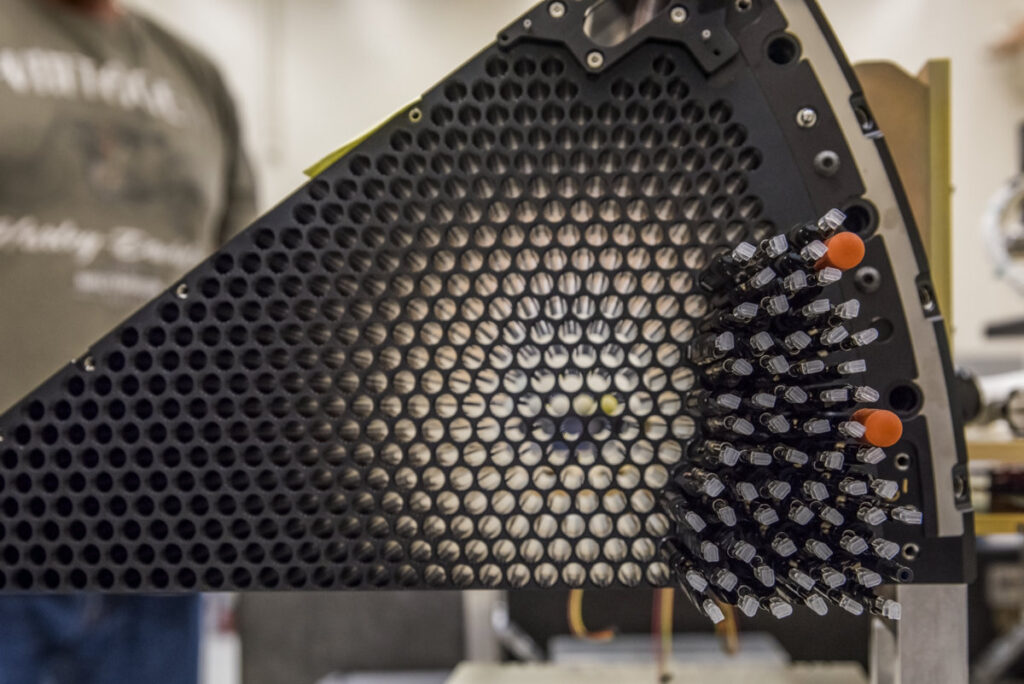
Photo of a focal plane assembly from DESI, which is mounted on a telescope and detects distance from cosmic light sources. DESI uses 5,000 fibre-optic “eyes” to gather light at a single point in time. Image © The Regents of the University of California, Lawrence Berkeley National Laboratory
The DESI researchers are, however, puzzling over why three measurement samples calibrated to the stable light of supernovas each produce different results for the rate of deceleration. All three, however, show that the universe’s expansion is slowing. The decreasing rate has also been observed by instruments other than DESI and, as one of the DESI researchers told New Scientist, the discrepancy likely results from the methods used to analyze the data.
New and more powerful telescopes soon coming online, including the Nancy Grace Roman Space Telescope and Vera C. Rubin Observatory, are expected to yield further information on dark energy or whatever it is that’s accelerating celestial objects at differing rates. Launching by May 2027, the Roman Telescope will have a field of vision 100 times greater than that of the Hubble telescope. The Rubin Observatory will use the largest camera ever built to scan the sky for 10 years from its location on a Chilean mountaintop to create an ultra-wide, ultra-high-definition time-lapse record of the universe while it also images millions of supernovas.
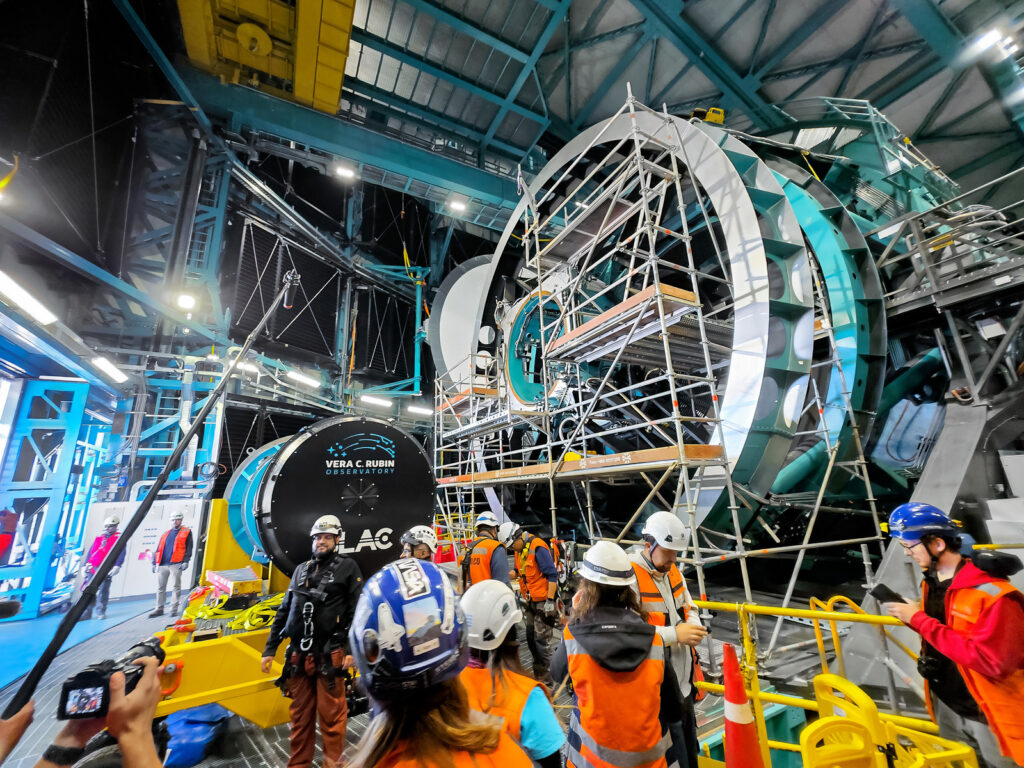
Installation of the world’s largest camera at the Vera C. Rubin Observatory in Chile. Image: RubinObs/NOIRLab/SLAC/NSF/DOE/AURA/B. Quint
At any rate of expansion, it appears that the relative positions of galaxies are not random.
Although telescopes cannot penetrate the cosmic microwave background (CMB), which is a barrier of plasma that shrouds the first 380,000 years of the universe’s existence, galaxies appear to follow a trajectory established by the varying densities evident in the CMB – as if the CMB is the original blueprint for the placement of matter over time. Scientists are studying the CMB in relation to the rate of universal expansion.
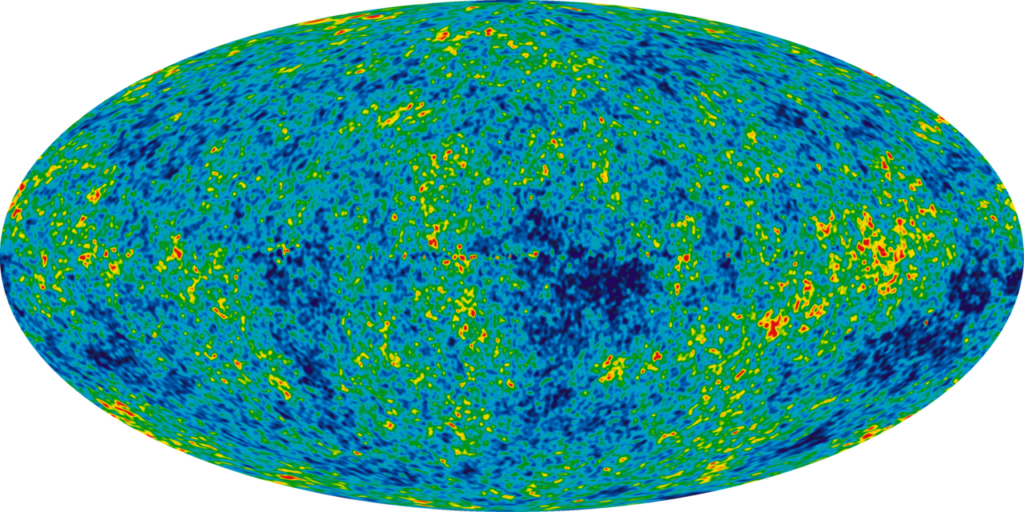
Image of the cosmic microwave background, a dense plasma cloud of unbound sub-atomic particles discovered in 1965 and imaged by a NASA probe between 2001 and 2010. Denoted by different colours, regional temperature differences appear to establish a template for the thermodynamic expansion of the universe. Image: Wikipedia .
Any conclusions drawn from data gathered by DESI and other powerful observational tools might prove to be provisional.
The universe has a habit of surprising us when it’s thought that a mystery, like dark energy and the rate of expansion, has been resolved.
The universe has a history of surprising even the most far-sighted scientists like Albert Einstein, who later admitted (according to cosmologist George Gamow) that the “biggest blunder” in his theory of general relativity was in thinking that the universe is static. In 1917, Einstein had inserted an expansionary factor in his field equations for general relativity, but the factor only counteracted the contraction of gravity and did not expand the size of the universe. Einstein called the limited expansionary factor the “cosmological constant.”
Edwin Hubble’s observation in 1929 that expansion exceeds gravitational contraction revealed Einstein’s error, although it also proved that the equations of general relativity require a factor that propels the growth of the universe. In 1998, the cosmological constant was redefined as a constant of acceleration and reinserted into the field equations of general relativity.
Now that evidence suggests the rate of acceleration is not a constant, what could account for the inconsistency? If the cosmological constant is redefined as a variable, will we find dark energy to be the cause of its variability, or will dark energy itself require redefinition? Whatever the answers are, it seems the universe has more surprises in store for science.
Craving more information? Check out these recommended TQR articles:
- How Many Languages Are There? Scientists Shed Light on What Animals Other Than Humans are Saying
- Wild Mathematics: Scientific Evidence of the Numerical Abilities of Animals
- Scientists Call for Halt to Creation of Mirror Bacteria, Warning of Global Risk to Life
- Time, the Sun, and Life: Even Bacteria Know When Earth Makes a Seasonal Change
- James Webb Space Telescope: Stunning Images Deliver New Insights on the Big Bang and Early Universe




